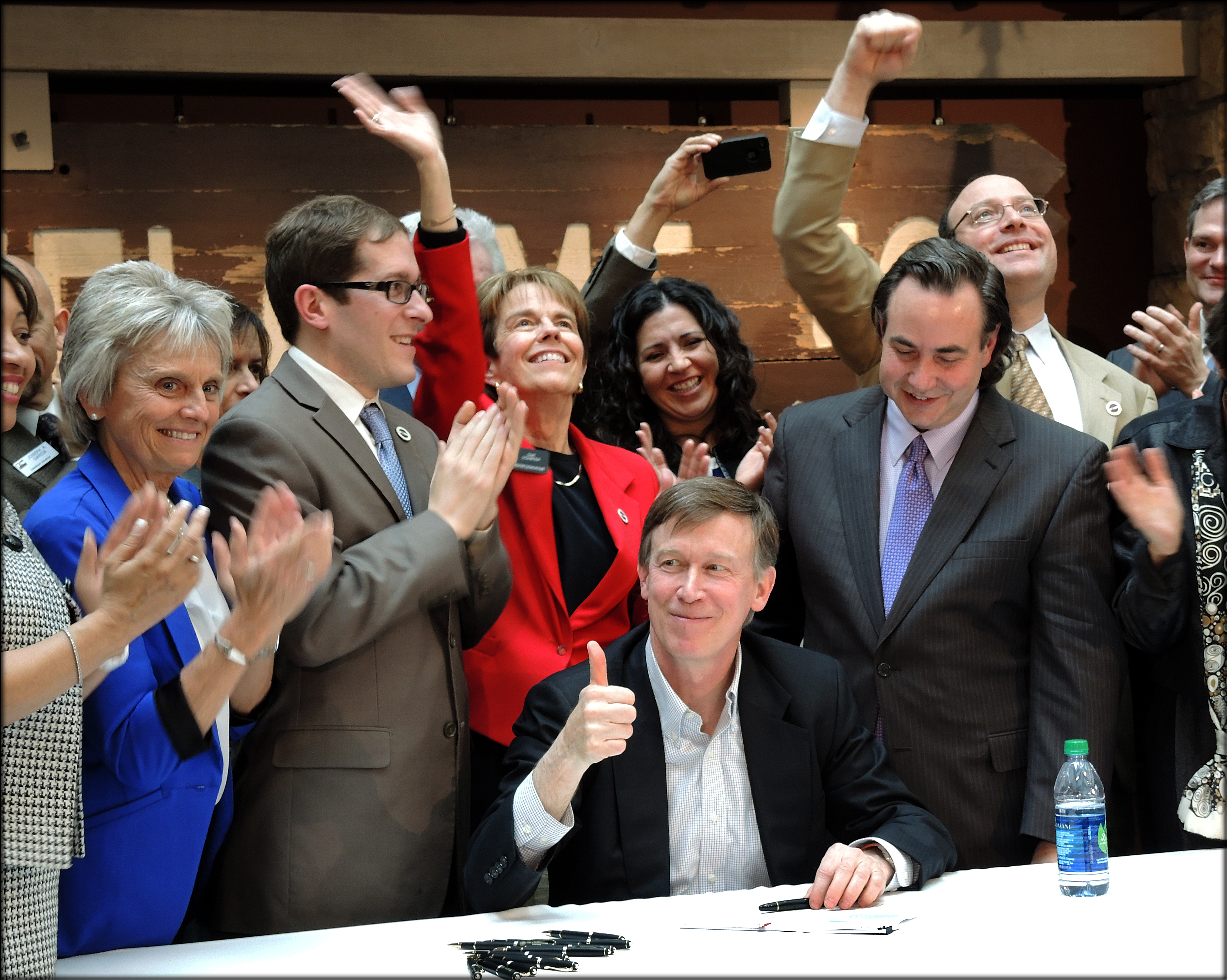Story
Expanding our collections to tell LGBTQ history
History Colorado’s exhibit Zoom In: The Centennial State in 100 Objects highlights the history of Colorado through the stories behind one hundred objects. At the end of the exhibit, we ask visitors to fill out a card identifying what they think the 101st object should be. In this blog post we share about visitors’ 101st object suggestions and what we’re doing in response to them.
The civil union license of Garth Criswell and Mark Craft from December 2013 sparked visitors’ interest in learning more about LGBTQ history in Colorado. “Civil unions were the latest effort in Colorado’s struggle to legislate LGBTQ rights,” the exhibit notes. “Boulder County briefly issued same-sex marriage licenses in 1975. In 1992 Amendment 2 prohibited any level of governmental protections for LGBTQ individuals in Colorado, until the US Supreme Court struck down the amendment in 1996.” You can find the newspaper coverage of these events at the Hart Research Library, a primary access point for the History Colorado collection—which holds the largest collection of Colorado newspapers in the world.
More recently, Colorado and LGBTQ rights made headlines again as the US Supreme Court reversed the Colorado Civil Rights Commission’s discrimination decision against Colorado bakery Masterpiece Cakeshop, whose owner cited religious beliefs in his refusal to make a wedding cake for a gay couple. The court didn’t ultimately rule on the conflict between religious beliefs and gay rights but instead held that commission officials had demonstrated “elements of a clear and impermissible hostility” to the baker’s religious beliefs in their ruling.
One of the newest additions to the History Colorado collection is a piece of rainbow ribbon and donor recognition buttons from the opening of a permanent rainbow crosswalk installed in the Baker Neighborhood at Broadway and Irvington. Initiated by the staff of the fashion resale business Buffalo Exchange, which hosts an annual “Crosswalk Walk-Off” event during June Pride Week, the crosswalk project took just over a year from idea to ribbon-cutting. The permitting and approval process involved Denver Public Works and the City Traffic Engineers. Denver Mayor Michael Hancock’s support was crucial to keeping the project moving forward.
Overnight on June 12, 2018, Colorado Barricade installed the crosswalk, which is made of a thermoplastic material for permanency. Over $25,000 of the $31,000 cost was privately raised from more than two hundred individual donors. The offices of Denver City Council members Jolon Clark and Robin Kneich, and the Buffalo Exchange, were significant contributors. The ribbon and buttons were donated by the office of councilmember Clark, in whose district the crosswalk lies.
While Denver isn’t the first city to install a rainbow crosswalk, the permanent nature of Denver’s is a visible symbol of support and acceptance for the LGBTQ community. One of the individuals involved in the crosswalk project shared that a gentleman in a wheelchair rolled up crying—he said he’d been a neighborhood resident for forty years and this was the most accepted he’d ever felt. In permanently featuring the rainbow symbol on a busy public thoroughfare, the crosswalk made an important and long-awaited statement to him. History Colorado staff also felt that statement was important and solicited the story and artifacts from councilmember Clark’s office.
A common challenge faced by institutions with large collections and a long history of collecting is that items can sometimes be hiding in plain sight if they haven’t been well documented. Curators work to uncover the stories behind the objects, but that work requires accurate records. Several visitors suggested that we include a rainbow flag as the 101st object. A quick search of the History Colorado collection database for the term “rainbow flag” turned up two artifacts identified as “Rainbow Coalition” flags.
The Rainbow Coalition grew out of the Reverend Jesse Jackson’s 1984 presidential campaign. Building on an idea created in the 1960s by former Black Panther Fred Hampton, Jackson advocated for an inclusive political organization that would address issues of social justice and political empowerment for traditionally marginalized populations. While the Rainbow Coalition included gay and lesbian individuals, it wasn’t specifically an LGBTQ organization.
Further research on History Colorado’s “rainbow coalition” flags revealed that one is plastic and mounted on a wooden dowel, like the mass-produced flags you see at demonstrations. It’s inscribed: “March on Washington April 25, 1993.” That march, with an estimated one million people in attendance, was for Lesbian, Gay and BiEqual Rights and Liberation. Jesse Jackson, president of the Rainbow Coalition, was one of the speakers, as were the leaders of other civil rights organizations. Film footage of the march shows many different groups carrying rainbow flags of all sizes. History Colorado’s rainbow flag tells multiple stories of the 1993 march and the coming together of people from many walks of life, but most importantly it symbolizes the struggle for LGBTQ rights and equality.
If you have a story or an item related to LGBTQ history that you’d be interested in sharing with us, we’d love to hear from you. You can reach us at curator@state.co.us. We’re looking for objects, images, and archival materials that visually embody the elements of a story and can help us tell that story in a variety of ways—in an exhibit, through research, and in publications and social media.

